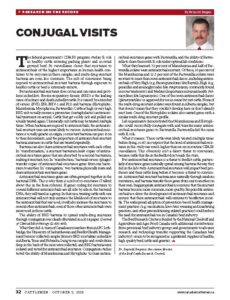Conjugal Visits
This article written by Dr. Reynold Bergen, BCRC Science Director, originally appeared in the October 2015 issue of Canadian Cattlemen magazine and is reprinted on the BCRC Blog with permission of the publisher.
The federal government’s CIPARS program studies E. coli in healthy cattle entering packing plants and in retail ground beef. Their surveillance shows that resistance to antimicrobials of the highest importance in human health continues to be very rare in these samples, and multi-drug resistant bacteria are even less common. The risk of consumers being exposed to antimicrobial resistant bacteria through exposure to healthy cattle or beef is extremely remote.
But antimicrobial resistance does occur, and can cause real problems in feedlots. Bovine respiratory disease (BRD) is the leading cause of sickness and death in feedlot cattle. It is caused by a number of viruses (BVD, IBR, BHV-1 and PI3) and bacteria (Histophilus, Mannheimia, Mycoplasma, Pasteurella). Cattle at high or very high BRD risk usually receive a preventative (metaphylactic) antimicrobial treatment on arrival. Cattle that get visibly sick and pulled are usually treated again. Chronically sick cattle may be treated multiple times. When bacteria are exposed to antimicrobials, the antimicrobial resistant ones are more likely to survive. Antimicrobial resistance is usually genetic in origin, so resistant bacteria can pass it on to their descendants, and the proportion of antimicrobial resistant bacteria increases in cattle that are treated repeatedly.
Bacteria can also share antimicrobial resistance with each other. In “transformation”, a resistant bacterium leaks copies of antimicrobial resistance genes that are absorbed by a second bacterium, making it resistant, too. In “transduction”, bacterial viruses (phages) transfer copies of antimicrobial resistance genes from one bacterium to another. In “conjugation”, two bacteria physically mate and share antimicrobial resistance genes.
Antimicrobial resistance genes are often grouped together in the bacterial DNA. This is why there is a risk of co-resistance (I talked about this in the June column). If genes coding for resistance to several different antimicrobials are all side-by-side in the bacterial DNA, they will travel as a group. In that case, treating cattle with one antimicrobial will not only increase the likelihood of resistance to the antimicrobial that was used, it will also increase the resistance to several other antimicrobials, even if those other antimicrobials were never used in those cattle.
The ability of BRD bacteria to spread multi-drug resistance through conjugation was clearly illustrated in a 2014 paper (Journal of Clinical Microbiology 52:438-448).
What they did
A team of Canadian researchers from AAFC Lethbridge, the University of Saskatchewan and Feedlot Health Management Services collected samples from 68 BRD mortalities in feedlots in Alberta, Texas and Nebraska. Lung tissue samples and swabs from deep in the back of the nose were collected, and BRD bacteria were isolated and tested for antimicrobial resistance. Conjugation studies tested the ability of Mannheimia and Histophilus to share antimicrobial resistance genes with Pasteurella, and the ability of Pasteurella to share them with E. coli under optimal lab conditions.
What they learned
72% of Mannheimia and half of Pasteurella isolates were antimicrobial resistant. Of these, 30% of the Mannheimia and 12.5% of the Pasteurella isolates were resistant to more than seven antimicrobial classes, including antimicrobials of Very High (e.g. fluoroquinolones like Baytril), High (e.g. penicillin and aminoglycosides like streptomycin, commonly found in scour treatments) and Medium Importance in human health (tetracyclines like Liquamycin). One of the seven antimicrobial classes (pleuromutilins) is approved for use in swine but not cattle. None of the multi-drug resistant isolates were found in Alberta samples, but that doesn’t mean that they couldn’t develop here or don’t already exist here. One of the Histophilus isolates also carried genes with a similar multidrug resistant profile.
Lab experiments demonstrated that Mannheimia and Histophilus could successfully conjugate with and transfer many antimicrobial resistance genes to Pasteurella. Pasteurella did the same with E. coli.
What it means
These cattle were likely treated multiple times before dying, so it’s no surprise that the level of antimicrobial resistance in this study was much higher than we see in routine CIPARS surveillance. This obviously isn’t a direct threat to consumers, because cattle that die in the feedlot don’t reach the store.
But antimicrobial resistance is a threat to feedlot cattle, particularly if resistance genes naturally spread among bacteria the way they did in the lab study. Antimicrobial resistance will impact beef producers and their cattle long before it becomes a threat to consumers. Antimicrobial resistant bacteria arise naturally through random mutations, and bacteria transfer those genes from one to another on their own. Inappropriate antimicrobial use ensures that the resistant bacteria become more common, more quickly. Responsible antimicrobial use slows the development of antimicrobial resistance and ensures that these antimicrobials will continue to be effective in cattle. The widespread adoption of prevention-based health management practices (e.g. vaccination, low stress weaning and marketing practices, and other preconditioning-related practices) could reduce the need for antimicrobial use in Canada’s beef industry.
Click here to subscribe to the BCRC Blog and receive email notifications when new content is posted.
The sharing or reprinting of BCRC Blog articles is typically welcome and encouraged, however this article requires permission of the original publisher.
We welcome your questions, comments and suggestions. Contact us directly or generate public discussion by posting your thoughts below.
